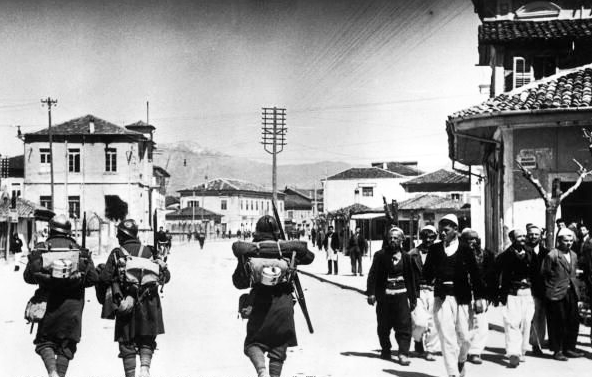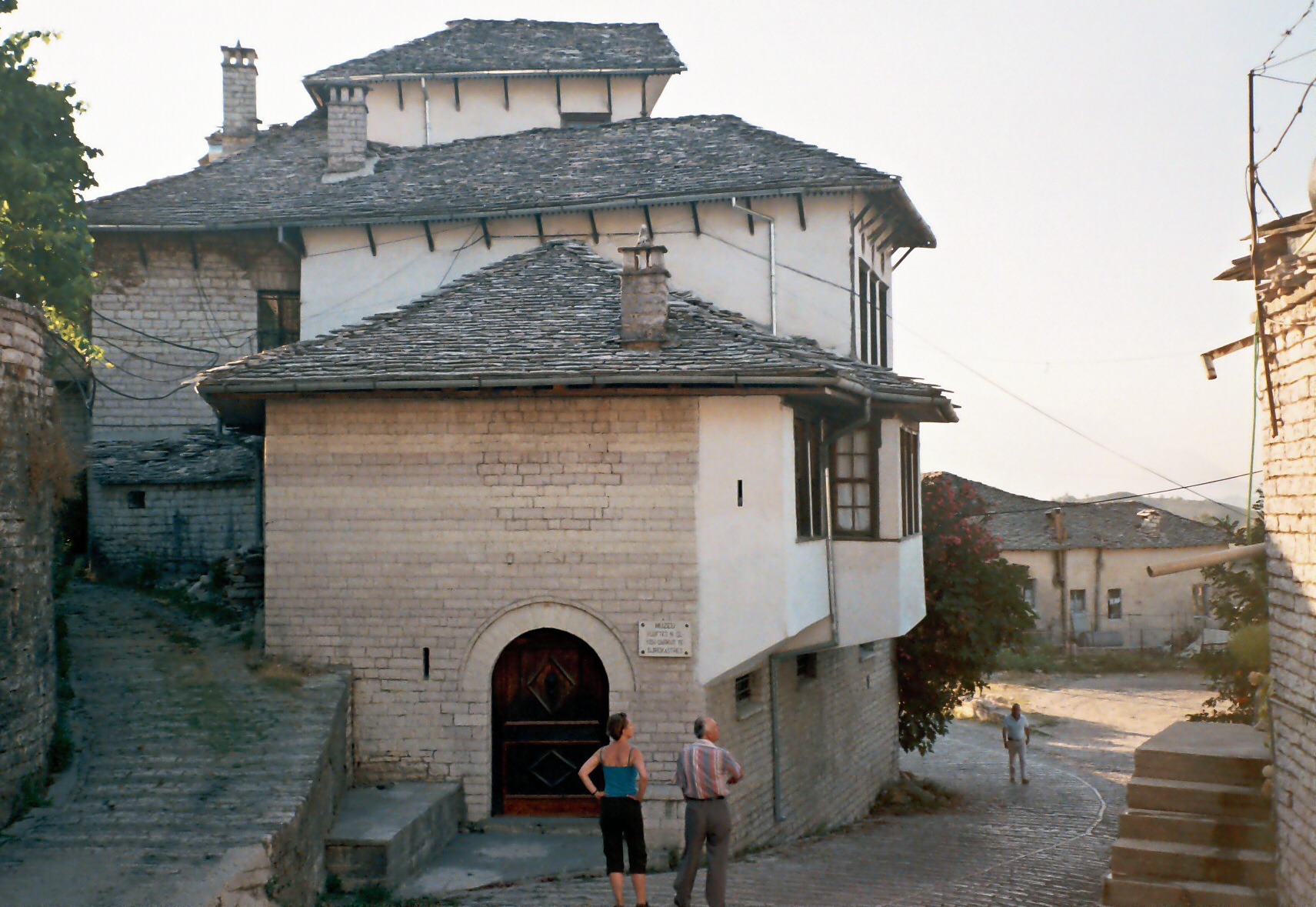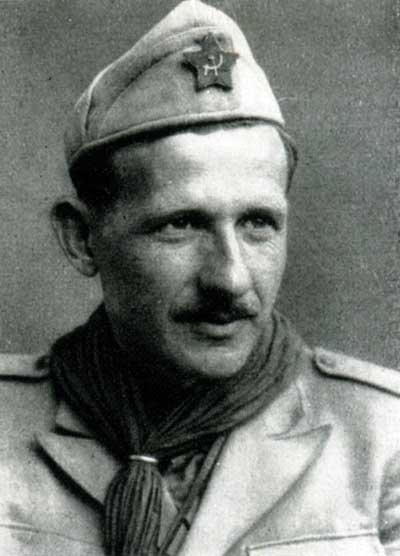|
Battle Of Drashovica
The Battle of Drashovica ( sq, Beteja e Drashovicës) was a battle of the Albanian Resistance of World War II against Nazi Germany. The battle took place in late 1943, in the areas of Drashovicë and Mavrovë in south-western Albania in the region of Shushicë. Prelude After the occupation of the Albanian Kingdom by the Kingdom of Italy in 1939, several resistance groups were formed. The most important of these groups were Balli Kombëtar (BK), a nationalist organization formed by Mit'hat Frashëri and Ali Këlcyra and the Albanian National Liberation Front (ANLF), which later became a Communist group led by Mehmet Shehu and Enver Hoxha. After the victorious battle of Gjorm and the establishment of German troops in Albania, many former Italian encampments became German bases, while many Italian soldiers were imprisoned for defection. In the Shushicë valley in the barracks of Drashovicë and Mavrovë the German army had imprisoned about 7,000 Italian soldiers guarded by abou ... [...More Info...] [...Related Items...] OR: [Wikipedia] [Google] [Baidu] |
Albanian Resistance Of World War II
In Albania, World War II began with its invasion by Italy in April 1939. Fascist Italy set up Albania as its protectorate or puppet state. The resistance was largely carried out by Communist groups against the Italian (until 1943) and then German occupation in Albania. At first independent, the Communist groups united in the beginning of 1942, which ultimately led to the successful liberation of the country in 1944. The Center for Relief to Civilian Populations (Geneva) reported that Albania was one of the most devastated countries in Europe. 60,000 houses were destroyed and about 10% of the population was left homeless. Background As Germany annexed Austria and moved against Czechoslovakia, Italy saw itself becoming a second-rate member of the Axis. After Hitler invaded Czechoslovakia without notifying Mussolini in advance, the Italian dictator decided in early 1939 to proceed with his own annexation of Albania. Italy's King Victor Emmanuel III criticised the plan to take A ... [...More Info...] [...Related Items...] OR: [Wikipedia] [Google] [Baidu] |
Albanian National Liberation Front
The National Liberation Movement ( sq, Lëvizja Nacional-Çlirimtare; or ''Lëvizja Antifashiste Nacional-Çlirimtare'' (LANÇ)), also translated as National Liberation Front, was an Albanian communist resistance organization that fought in World War II. It was created on 16 September 1942, in a conference held in Pezë, a village near Tirana, and was led by Enver Hoxha. Apart from the figures which had the majority in the General Council it also included known nationalists like Myslim Peza. In May 1944, the Albanian National Liberation Front was transformed into the government of Albania and its leaders became government members, and in August 1945, it was replaced by the Democratic Front. The Albanian National Liberation Army (''Ushtria Nacional-Çlirimtare'') was the army created by the National Liberation Movement. Background Italian invasion Albania did not put an organized resistance to the Italian invasion (April 7–12, 1939). However different Albanian groups of patriot ... [...More Info...] [...Related Items...] OR: [Wikipedia] [Google] [Baidu] |
Military History Of Albania During World War II
In Albania, World War II began with its invasion by Italy in April 1939. Fascist Italy (1922–1943), Fascist Italy set up Albania as its protectorate or puppet state. The resistance was largely carried out by Communist groups against the Kingdom of Italy, Italian (until 1943) and then Nazi Germany, German occupation in Albania Albania ( ; sq, Shqipëri or ), or , also or . officially the Republic of Albania ( sq, Republika e Shqipërisë), is a country in Southeastern Europe. It is located on the Adriatic and Ionian Seas within the Mediterranean Sea and share .... At first independent, the Communist groups united in the beginning of 1942, which ultimately led to the successful liberation of the country in 1944. The Center for Relief to Civilian Populations (Geneva) reported that Albania was one of the most devastated countries in Europe. 60,000 houses were destroyed and about 10% of the population was left homeless. Background As Germany annexed Austria and move ... [...More Info...] [...Related Items...] OR: [Wikipedia] [Google] [Baidu] |
1943 In Albania
Events Below, the events of World War II have the "WWII" prefix. January * January 1 – WWII: The Soviet Union announces that 22 German divisions have been encircled at Stalingrad, with 175,000 killed and 137,650 captured. * January 4 – WWII: Greek-Polish athlete and saboteur Jerzy Iwanow-Szajnowicz is executed by the Germans at Kaisariani. * January 11 ** The United States and United Kingdom revise previously unequal treaty relationships with the Republic of China. ** Italian-American anarchist Carlo Tresca is assassinated in New York City. * January 13 – Anti-Nazi protests in Sofia result in 200 arrests and 36 executions. * January 14 – 24 – WWII: Casablanca Conference: Franklin D. Roosevelt, President of the United States; Winston Churchill, Prime Minister of the United Kingdom; and Generals Charles de Gaulle and Henri Giraud of the Free French forces meet secretly at the Anfa Hotel in Casablanca, Morocco, to plan the Allied European strategy for the ... [...More Info...] [...Related Items...] OR: [Wikipedia] [Google] [Baidu] |
Conflicts In 1943
Conflict may refer to: Arts, entertainment, and media Films * ''Conflict'' (1921 film), an American silent film directed by Stuart Paton * ''Conflict'' (1936 film), an American boxing film starring John Wayne * ''Conflict'' (1937 film), a Swedish drama film directed by Per-Axel Branner * ''Conflict'' (1938 film), a French drama film directed by Léonide Moguy * ''Conflict'' (1945 film), an American suspense film starring Humphrey Bogart * ''Catholics: A Fable'' (1973 film), or ''The Conflict'', a film starring Martin Sheen * ''Judith'' (1966 film) or ''Conflict'', a film starring Sophia Loren * ''Samar'' (1999 film) or ''Conflict'', a 1999 Indian film by Shyam Benegal Games * ''Conflict'' (series), a 2002–2008 series of war games for the PS2, Xbox, and PC * ''Conflict'' (video game), a 1989 Nintendo Entertainment System war game * '' Conflict: Middle East Political Simulator'', a 1990 strategy computer game Literature and periodicals * ''Conflict'' (novel) ... [...More Info...] [...Related Items...] OR: [Wikipedia] [Google] [Baidu] |
Kaninë
Kaninë is a settlement in the Vlorë County, southwestern Albania. At the 2015 local government reform it became part of the municipality Vlorë. It is home to the Kaninë Castle. Name The name of the fortified settlement of Kanina was attested for the first time at the beginning of the 11th century AD in Byzantine Greek as (in plural form). The toponym is significant for the history of the Albanian language since ''Kanina'' represents a toponym that shows no sign of the dialect phenomenon of rhotacism, which is explained by the fact that the settlement was recorded with the name ''Kanina'' in a period during which rhotacism in Albanian was no longer active for some time. On the other hand the name of nearby ''Vlorë'', attested earlier, was subject to the Albanian rhotacism. History The settlement of Kaninë developed below a hilltop Kaninë Castle which overlooks the village. The first phase of the fort dates to the late 4th/early 3rd century BCE and is linked to the developmen ... [...More Info...] [...Related Items...] OR: [Wikipedia] [Google] [Baidu] |
Battle Of Gjorm
The Battle of Gjorm ( sq, Beteja e Gjormit) was a battle of the Albanian Resistance of World War II against the Kingdom of Italy. The battle took place on January 1–2, 1943, in the areas of Gjorm, Vranisht, Dukat, Tragjas and Tërbaç in south-western Albania. Prelude After the occupation of the Kingdom of Albania by the Kingdom of Italy in 1939, several resistance groups were formed. The most important of these groups were Balli Kombëtar, a nationalist organization formed by Mit'hat Frashëri and Ali Këlcyra and the Albanian National Liberation Front, which later became a communist group led by Mehmet Shehu and Enver Hoxha. Dukat and Gjorm became two of the centers of Balli Kombëtar, whose forces in the region were led by Hysni Lepenica, a military commander, and Skënder Muço, a prominent lawyer from Tragjas. Mehmet Shehu, a commander of the Albanian National Liberation Front, created a partisan unit in the wider region of Mallakastër. Beginning in mid-1942, th ... [...More Info...] [...Related Items...] OR: [Wikipedia] [Google] [Baidu] |
Enver Hoxha
Enver Halil Hoxha ( , ; 16 October 190811 April 1985) was an Albanian communist politician who was the authoritarian ruler of Albania from 1944 until his death in 1985. He was First Secretary of the Party of Labour of Albania from 1941 until his death in 1985. He was also a member of the Politburo of the Party of Labour of Albania, chairman of the Democratic Front of Albania, and commander-in-chief of the armed forces and ruled the country from 1944 until his death in 1985. He was the 22nd Prime Minister of Albania from 1944 to 1954 and at various times was both foreign minister and defence minister of the People's Socialist Republic of Albania. Hoxha was born in Gjirokastër in 1908 and became a grammar school teacher in 1936. Following the Italian invasion of Albania, he joined the Party of Labour of Albania at its creation in 1941 in the Soviet Union. He was elected First Secretary in March 1943 at the age of 34. Less than two years after the liberation of the country ... [...More Info...] [...Related Items...] OR: [Wikipedia] [Google] [Baidu] |
Mehmet Shehu
Mehmet Ismail Shehu (January 10, 1913 – December 18, 1981) was an Albanian communist politician who served as the 23rd Prime Minister of Albania from 1954 to 1981. As an acknowledged military tactician, without whose leadership the communist partisans may well have failed in their battle to win Albania for the Marxist-Leninist cause, Shehu exhibited an ideological understanding and work ethic that singled him out for rapid promotion in the communist party.Europe since 1945: an encyclopedia, Volume 1 Author Bernard A. Cook Publisher Taylor & Francis, 2001 , Mehmet Shehu shared power with Enver Hoxha from the end of the Second World War. According to official Albanian government sources, he committed suicide on December 18, 1981, after which his family was arrested. Persistent rumors remain, however, that Shehu was actually murdered on orders from Hoxha. Early years Shehu was born in Çorrush, Mallakastër District, southern Albania, in the family of a Tosk Muslim Imam. S ... [...More Info...] [...Related Items...] OR: [Wikipedia] [Google] [Baidu] |
Ali Këlcyra
Ali Bey Këlcyra (May 28, 1891 – September 24, 1963) born Ali Klissura, was an Albanian lord and a member of the Albanian parliament in the 1920s. He was co-founder with Mid'hat Frashëri of the Balli Kombëtar organization in 1942, and the cosigner of the Dalmazzo-Këlcyra agreement with Lorenzo Dalmazzo.European resistance movements, 1939-1945: proceedings Page 12 Biography Early life Këlcyra was born in Këlcyrë on 28 May 1891, to Xhemal bey Klissura and Hana Luarasi. He went to grammar school in Këlcyrë and then graduated from the Galatasaray High School in Istanbul, Turkey (then Ottoman Empire). He then studied political and administrative sciences at the Mülkiye school in Istanbul. After the beginning of World War I he returned to Këlcyrë. During the Greek Invasion of Albania in 1914 he went to Vlorë along with other emigrants. He met there with Prince Von Wied and the princess Sophie who had come to visit the emigrants. He left the country to go to San De ... [...More Info...] [...Related Items...] OR: [Wikipedia] [Google] [Baidu] |
Albania
Albania ( ; sq, Shqipëri or ), or , also or . officially the Republic of Albania ( sq, Republika e Shqipërisë), is a country in Southeastern Europe. It is located on the Adriatic and Ionian Seas within the Mediterranean Sea and shares land borders with Montenegro to the northwest, Kosovo to the northeast, North Macedonia to the east and Greece to the south. Tirana is its capital and largest city, followed by Durrës, Vlorë, and Shkodër. Albania displays varied climatic, geological, hydrological, and morphological conditions, defined in an area of . It possesses significant diversity with the landscape ranging from the snow-capped mountains in the Albanian Alps as well as the Korab, Skanderbeg, Pindus and Ceraunian Mountains to the hot and sunny coasts of the Albanian Adriatic and Ionian Sea along the Mediterranean Sea. Albania has been inhabited by different civilisations over time, such as the Illyrians, Thracians, Greeks, Romans, Byzantines, Venetians, and Ot ... [...More Info...] [...Related Items...] OR: [Wikipedia] [Google] [Baidu] |




